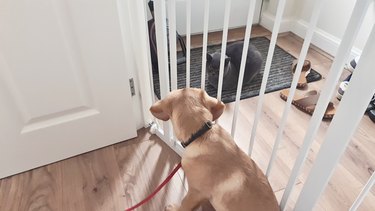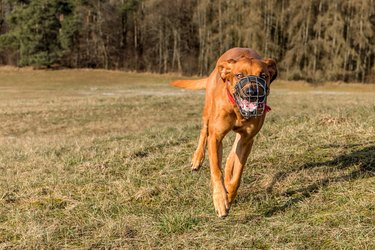There are plenty of dog behaviors that are, let's say, unpleasant to live with. Barking, jumping, chewing on furniture, and snatching goodies off the counter are actually all extremely normal and natural things for a dog to do, but for the sake of everyone's safety and sanity, it's typically best to find ways to stop them. Whether you are working with a qualified professional trainer or flying solo, it is important that our training plan incorporates some kind of management strategy.

Video of the Day
What is management?
Management is the simple art of changing the environment to prevent, or at least minimize, problematic behaviors from happening. You might be thinking: "if I could just stop the behavior from happening in the first place, we would not be having this conversation." But managing the environment is not just a way to sweep problems under the rug or avoid training your dog. It's actually a critical part to any good behavior modification plan!
Video of the Day
Why is management important?
Dogs do what works. If your dog is consistently doing a specific behavior, it is because something in the environment is reinforcing it. By pure definition, behaviors that are reinforced are more likely to continue. For example, every time your dog barks at the mail carrier, that behavior of barking is reinforced by the mail carrier leaving. As far as your dog is concerned, barking is highly effective at getting the threat to leave the property. Each time that behavior is reinforced, it becomes even more likely to continue. In order to ultimately stop that barking, we need to find a way to prevent the issue while we work on alternative behaviors.
Genuine learning and behavior change can take time. While your dog is learning new skills that trainers will use to replace undesirable habits, we need to find ways to make sure the old behaviors are not being rehearsed.
The good news is that management can be temporary, and you can always scale it back once you and your dog are further along in your training plan! It's also perfectly acceptable to choose to permanently manage a behavior rather than train through it in some situations. Even professional trainers implement management regularly to make life easier and more pleasant for everyone involved. For instance, you might have the skills and know-how to teach your dog to leave the kitchen trash alone, and still decide it's more practical and less time-consuming to simply buy a new can with a lid.

Common management examples
Let's get into some common behavior issues and how we could potentially use management as a strategy to prevent the issue from worsening as training takes place. These are by no means comprehensive training plans, and when in doubt you should contact a qualified professional trainer for help!
- Issue: Teddy the schnauzer barks at passersby through the living room window.
Management solutions: Block off the living room with a baby gate, close the blinds, or install window privacy film to prevent Teddy from seeing anyone walking in front of the house. - Issue: Maggie the golden retriever excitedly jumps on guests when they enter the home.
Management solutions: Have Maggie on leash or behind a baby gate when guests enter until she is able to calm down. - Issue: Pongo the labrador steals and consumes food left on the kitchen counters.
Management solutions: Triple-check to ensure counters are empty, or block off access to the kitchen entirely with baby gates or exercise pens to keep Pongo from scoring goodies. - Issue: Hugo the pitbull puppy chews the legs of the couch,
Management solutions: Have Hugo spend time in a puppy-proofed playpen away from the couch when he is unsupervised. - Issue: Poseidon the husky rushes past people and runs around the neighborhood when the door is open.
Management solutions: Install an extra barrier around the door, or have Poseidon on a leash when letting people into or out of the home.

The bottom line
Management and training compliment each other beautifully when you are working through a behavior issue with your dog. The best dog trainers try to be proactive rather than reactive. Rather than setting a dog up to fail and punishing the "wrong" response, we recommend setting the environment up so that all parties can be successful. Happy training (and managing)!